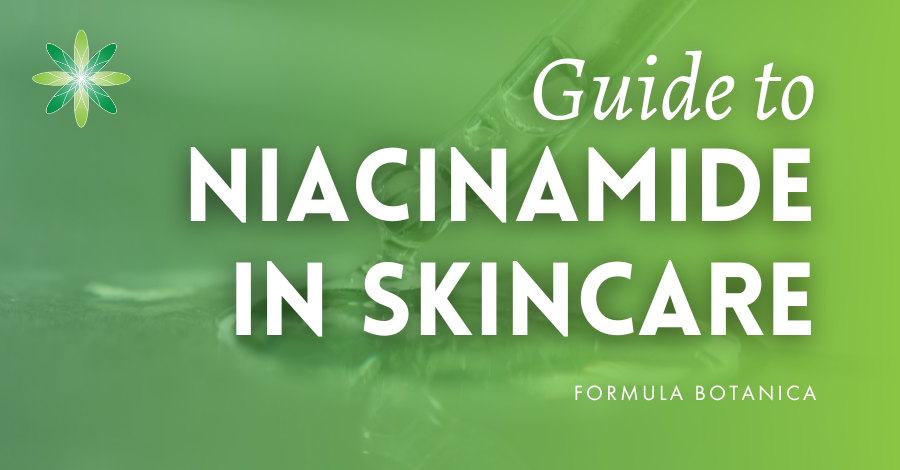Welcome to your ultimate guide to niacinamide, the trendy skincare ingredient everyone is talking about! As a cosmetic active, niacinamide has rapidly risen to prominence – and for many good reasons.
With proven effectiveness in a range of skin concerns, wide availability, affordable price, and excellent safety profile, niacinamide truly stands out in the world of skin care. Add to that its compatibility with other ingredients and ease of use in formulations, and it’s clear why niacinamide shines so brightly in the beauty space.
Whether you’re new to niacinamide or a seasoned fan, this essential guide to niacinamide will walk you through everything you need to know about this powerful active ingredient. Plus, we’ve put together a bonus list of beginner-friendly niacinamide skin care formulas that you can make at home. Are you ready to unlock the full potential of niacinamide? Let’s get started!
What is niacinamide?

INCI: Niacinamide
Vitamin B3, also known as niacinamide or nicotinamide, is a high-performance skin care active ingredient renowned for its remarkable skin-brightening properties. As you dive deeper into this guide to niacinamide, you’ll discover how this versatile ingredient can transform your skincare formulas.
Vitamin B3 can be found as nicotinic acid or niacinamide. Nicotinic acid is more readily found in plant sources, while niacinamide is usually found in animal products. While you can find niacinamide naturally in various plant and animal sources, niacinamide is usually produced synthetically to ensure complete purity and keep costs down. This means that niacinamide is not a natural ingredient and is not accepted by natural and organic certification standards.
However, we’re making an exception here because even though niacinamide isn’t technically natural, it’s all about nature and full of benefits. When we say “nature-identical,” we are referring to the fact that synthetic niacinamide has the exact same chemical structure as naturally occurring niacinamide.
This means that whether extracted from plants, animals, or synthesized in a lab, the resulting niacinamide molecule is identical and works the same way for your skin. In theory, niacinamide could come from plant sources such as maize (corn), wheat or other grains, which contain the precursor compound nicotinic acid. However, synthesizing niacinamide in the laboratory ensures a reliable and economical choice for skin care products.
You can learn more about the 4 shades of physical and natural certification systems below:
Podcast 1: What is natural skin care?
Podcast 120: How Many Beauty Certification Programs Do We Need?
15 Certification Programs for Sustainable Beauty Brands
The benefits of niacinamide for the skin


Niacinamide offers so many skin care benefits that it’s hard to go back once you start using it. Non-irritating and suitable for all skin types, this versatile ingredient can be incorporated into both day and night formulas — and that’s just the beginning.
This guide to niacinamide will also cover how to compound with this active to maximize its benefits. Here are some of the top benefits of niacinamide for skin:
Skin glow
Niacinamide is a key ingredient for skin radiance – it can help reduce hyperpigmentation, even out skin tone and give your complexion a luminous glow.
It’s also great for mature skin as it can help support collagen and elastin production, which helps minimize the appearance of fine lines.
Strengthens the skin barrier
Niacinamide helps increase the production of ceramides, which are part of the lipid structure of the skin. As we age, ceramide levels in the skin decrease, compromising lipid balance and weakening the skin barrier.
Niacinamide helps strengthen the barrier and its ability to prevent water loss and protect against external irritants. Learn more about the skin barrier below:
Skin Barrier 101: an essential guide for natural cosmetics makers
Savior for blemish-prone skin
In addition to strengthening the skin barrier, niacinamide can help calm acne-related inflammation. It also helps control sebum production, tightens pores, and boosts hydration—a welcome relief, especially since many acne treatments can be drying. Learn more about how to formulate for acne-prone skin below:
Formula for acne-prone skin: Dos, don’ts and myths
Formulation method with niacinamide


Incorporating niacinamide into your skin care formulations is simple as long as you follow a few simple guidelines.
- Solubility: Niacinamide is water soluble, meaning it is best added to the water phase of your formula. Just stir until completely dissolved.
- Synthesis phase: While niacinamide can be heated up to 70°C for emulsions, it is often best to add it during the cooling phase, below 40°C, to maintain its effectiveness.
- Usage rate: Typical usage ranges from 2% to 4%, although it can go as high as 10% depending on the goals of the formulation. Always check your supplier’s recommendations to ensure optimal results.
- pH: When working with niacinamide, aim for a final product pH of around 6. This is not a hard and fast rule, but serves as a guideline to keep the pH closer to neutral. In highly acidic environments, niacinamide can be converted to niacin, which can cause temporary redness. However, this reaction requires extreme conditions and is unlikely in standard synthesis practice. In practice, the lower pH is not much of a problem. Formulation with niacinamide at pH 5 will not cause tingling and redness, for example. This skin reaction is often caused by nicotinic acid which remains impurities from the production process, so it depends more on the quality of the raw material than on the pH of the formulation. Learn more about pH below:
What can go wrong if you don’t control the pH of your formulation?
For an in-depth understanding of niacinamide formulation, including pH adjustments and synergistic combinations with other active ingredients, explore our exclusive Vitamin B3 Mini Lab available in The Lab at Formula Botanica.
Niacinamide & Vitamin C


A common question among novice brewers is whether niacinamide can be combined with vitamin C. The answer is yes! It is compatible with most active.
While pure ascorbic acid can be difficult to stabilize, consider using a stable derivative such as tetrahexyldecyl ascorbate (THD) or ascorbyl glucoside for a more reliable formulation. For more information on vitamin C, see these posts:
The best forms of vitamin C in natural skin care
4 Vitamin C Skincare Myths Every Formulator Should Know
Shine with niacinamide: 4 formulas you must try
Gel cream
How to make a soothing after sun cream
After a day at the beach, skin craves moisture but not essential oils, which can trap heat and feel uncomfortable. This silky light skin moisturizer is the perfect balance between a cool gel and a moisturizer. Did I mention it’s the color of the ocean?
Body serum
How to make an invigorating body serum
This creamy, lightweight body serum brightens with niacinamide and a stabilized form of vitamin C, while giving the skin barrier an extra boost with oat extract. This is the intermediate layer, but it comes together quickly and is worth it.
Create your own niacinamide products
We hope you enjoyed our guide to niacinamide! Niacinamide is a must-have item for any formulators toolbox, especially if you’re just starting out. This versatile, high-impact ingredient is incredibly easy to use, making it ideal for beginners.
Ready to start making your own effective skin care products? Our essential Diploma in Organic Skincare will guide you step-by-step, helping you create beautiful results-driven formulas from the ground up.
Leave us a comment


Shauna is a copywriter and content creator at Formula Botanica. Her love for beauty began with the creation of a cosmetic kit for children. A former beautician, Shauna is also an active formulator and perfumer and member of the Formula Botanica community.


